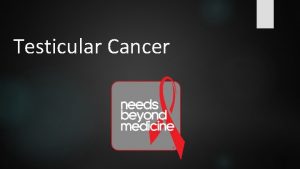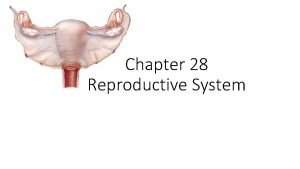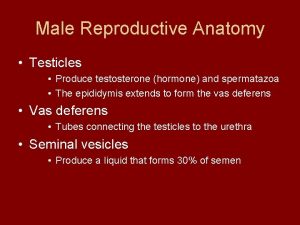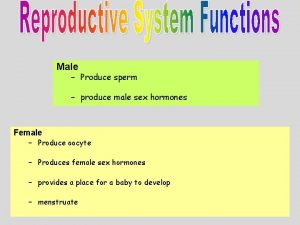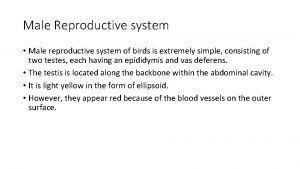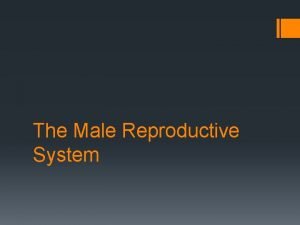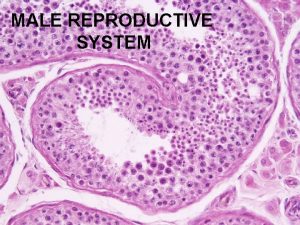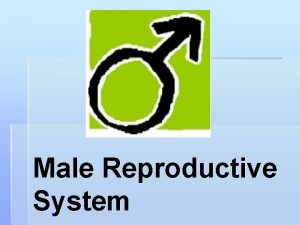Male Reproductive System Male Reproductive System Testicles produce














- Slides: 14

Male Reproductive System

Male Reproductive System • Testicles: produce sperm (male sex cell), and testosterone • Epididymis: network of tubes behind testicle which store sperm cells • Vas Deferens: passageway tubes that extend epididymis to urethra, where sperm exits • Scrotum: keeps sperm cool • Semen: fluids and sperm mixture exits penis through ejaculation

Secondary Sexual Characteristics - Male • Produced by testosterone – Deeper voice – Chest and facial hair – Lengthen bones – Increased size of testes for sperm production

Female Reproductive System Mrs. Degl

Female Reproductive system • Key functions: store and release eggs, role in creation of offspring, to give birth. • Fertilization: this occurs when a sperm cell joins with a female’s egg cell. • Ovulation: the release of one egg cell per month (about 28 days). • Menstruation: when the lining of the uterus, unfertilized egg, and blood flow out of the body. • Menstrual cycle: hormonal changes that occur from the beginning of one menstruation to the next (28)

• Ovaries: contain ova, or the eggs, and produce hormones • Fallopian tubes: carry eggs from ovaries to uterus • Uterus: shelters and nourishes fetus • Cervix: opening of the uterus • Vagina: muscular passageway from the uterus to the outside of the body

Secondary Sexual Characteristics - Female • Induced by increased LH, FSH, estrogen, and progesterone hormone levels – Pubic hair – Widen pelvis – Enlarge mammary tissue (breasts) – Begin menstrual cycles

Fertilization • • Occurs in upper 1/3 of Fallopian tube Only 1 sperm can fertilize an egg Fertilized egg = zygote An average woman is pregnant (gestational period) for 9 whole months. That is 40 weeks. Babies can survive if they are born earlier, but they may have complications due to being premature.

Implantation • Fertilized eggs are implanted into thick walls of uterus • Chorion membranes dig into uterus to form placenta • Zygote grows into an embryo • Embryo gets air and nutrients through the umbilical cord • Once pregnant, progesterone levels stay high in mom • Mom’s uterus grows with the baby

1 st Trimester = 1 st 12 weeks • Heart develops first • Neural tube develops • All body systems appear by Week 8 – Now a Fetus

2 nd Trimester = up to 24 weeks • Most growth • Looks more like a baby • Some preemies survive at this stage

3 rd Trimester = Up to 40 weeks • • • More growth Kicking, rolling, stretching Eyes open – Week 32 Lungs mature Rotates to head-down position, unless baby is breech

Birth • Labor – Uterine contractions begin – Cervix dilates to 10 cm. • Birth – Uterus pushes baby through vaginal canal – Placenta delivered after baby – Cesarean Section (c-section) is a surgery that cuts through the uterus to deliver the baby if it cannot be born vaginally

Human Growth Stages • • Infancy: Birth-2 years Childhood: 2 -13 years Adolescence: 13 -18/20 years Adulthood: 20 years until death
 Different types of testicles
Different types of testicles Loose testicles
Loose testicles Dartos fascia
Dartos fascia Hertrosexual
Hertrosexual Hyena testicles
Hyena testicles Function of vagina
Function of vagina Reproductive hygiene
Reproductive hygiene Frog testis labeled
Frog testis labeled Exercise 42 anatomy of the reproductive system
Exercise 42 anatomy of the reproductive system Lutalphase
Lutalphase Female sex organ diagram
Female sex organ diagram Male fallopian tube
Male fallopian tube Figure 16-1 is a sagittal view of the male reproductive
Figure 16-1 is a sagittal view of the male reproductive Luteinizing hormone in male reproductive system
Luteinizing hormone in male reproductive system Human reproductive system
Human reproductive system
